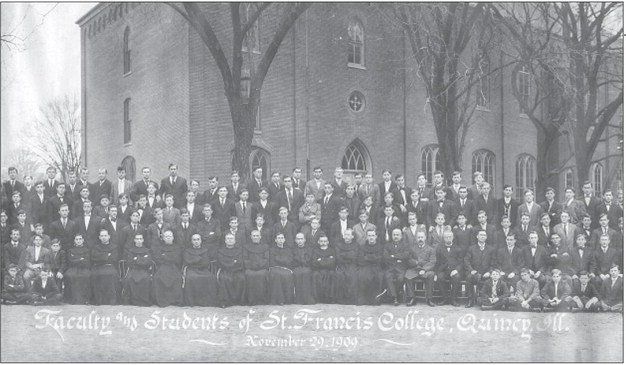Quincy University: A glance at a community treasure

Founded in 1860, Quincy University is a liberal arts institution grounded in the mission of St. Francis of Assisi.
Located at 18th and College, the university today serves more than 1,000 undergraduate and graduate students. For more than 150 years, Quincy University has been a staple of life in the Gem City, but it has gone through many changes since it opened.
The school began in 1860, when a group of Franciscan friars received permission from their superiors in Germany to charter a school. The first college classes were offered at a small three story-building on the south side of Eighth and Maine Streets in 1860. Around the same time, a new Catholic parish, St. Francis Solanus, opened on 18th and Vine (now College Avenue), and in 1865 the college friars began teaching classes in the parish school.
With just a few dozen students and few faculty members, the friars struggled to keep the college going, but under the direction of a young German friar, Father Anselm Mueller, St. Francis Solanus College, grew and in 1873 the state of Illinois chartered Quincy College.
Over the next few decades, the college continued to expand, though it still mostly served the large German Catholic population in the Quincy area. For decades, enrollment stood between 100 to 300 students, with that number rising to 400 only in the 1930s. Initially the college did not admit women.
Most Catholic schools at the time, along with many other private institutions, were segregated by sex, so it was not unusual that during its first sixty years Quincy College had no women. In 1922 the first female students registered for classes.
But what did stand out about Quincy College, and shows how open an environment that has marked it since 1860, was the presence of an African American student.
He was to become the first Roman Catholic priest in the United States, and one who is on the canonical path to sainthood. Born into a slave family in Missouri, Augustine Tolton moved to Quincy shortly after the Civil War broke out.
At the time Quincy had an African American population of about 300, sizable enough for the family to feel at home. The Toltons, however, were Catholic, a rarity among African Americans. His mother sent Augustine to St. Boniface School, where the child suffered racial taunts and worse from the other children.
When the situation grew intolerable, Augustine left the school and received private tutoring from a Catholic priest, Father Michael Richardt. A brilliant student, Augustine thrived and even became fluent in German. By his early teens, Augustine yearned to enter the priesthood, but the racism of the day threatened to deny him his calling, as no seminaries in the United States would allow in a black student. He entered Quincy College as a student in 1878 and with the aid of Father Richardt entered a seminary in Rome and was ordained in 1886. Father Tolton died in Chicago in 1897, but asked to be buried in Quincy in St. Peter’s Cemetery, where his body rests today.
By the early 20th century, the college was expanding and the construction of Francis Hall continued. In 1917 the college changed its name again, this time to Quincy College and Seminary. After thriving for decades, the college, along with the rest of nation, suffered greatly as a result of the Great Depression and during the 1930s the college had to lay off all but two members of its faculty.
Times were not much easier during World War II, as enrollment dropped and all varsity athletics were canceled. But the college stayed open and began to grow during the 1950s. In 1959 enrollment for the first time topped 1,000 students. During the 1940s and 1950s, as enrollment grew, the character of the college changed.
Ever since the 1860s, most of Quincy’s students were local
residents who commuted to school. But, thanks in part to the GI Bill created
for World War II veterans, college become accessible to millions of young
men and women who previously would not have been able to afford the tuition.
Higher education enrollment boomed during the 1940s through
the 1960s, and Quincy College saw a sharp upsurge, which necessitated construction
of new residence halls to house the students. Between 1957 and 1965, Quincy
opened five dormitories, several of which still are operating today. With the
influx of students came an expansion of extracurricular activities,
particularly in athletics, a tradition that carries on today, as the university
competes in fifteen men’s and women’s sports programs.
In 1993 the school officially adopted its present name, “Quincy University.” The university celebrated its 150th anniversary in 2009-2010, and it continues to be a staple of life in Quincy and the surrounding community.
The university today continues to change; a new student living center opened on 18th and Lind Streets in August 2011, but Quincy University continues the traditions handed down from its beginnings in 1860: a Franciscan institution, guided by the principles of Francis of Assisi.
The university’s mission statement reads in part: “Quincy University stands as a Catholic, independent, liberal arts institution of higher learning in the Franciscan tradition. Inspired by the spirit of Francis and Clare of Assisi, we respect each person as a sister or brother with dignity, value, and worth. We work for justice, peace and the integrity of creation.”
It is those values that have shaped Quincy University since its inception and that spirit lives on today.
Justin P. Coffey is associate professor of history at Quincy University. He is the author of numerous articles on American history and is on the board of the Historical Society.






